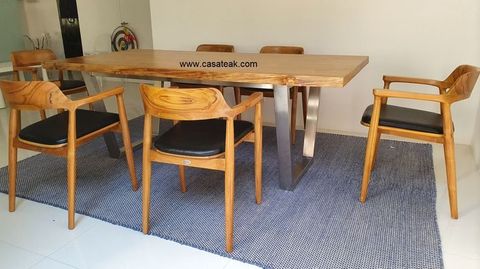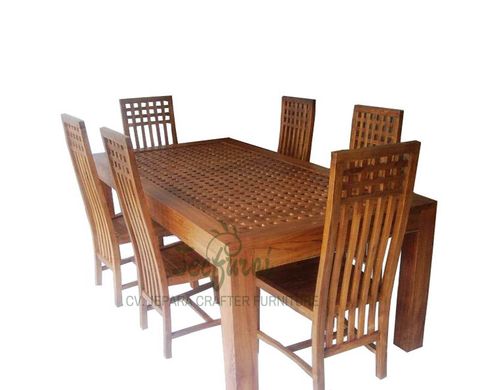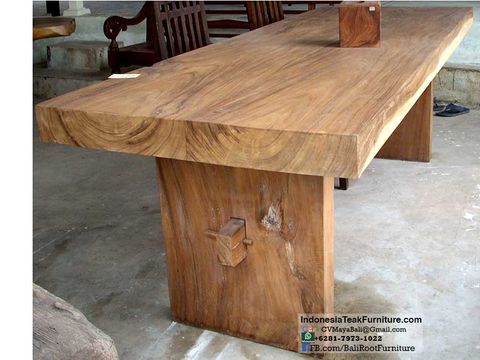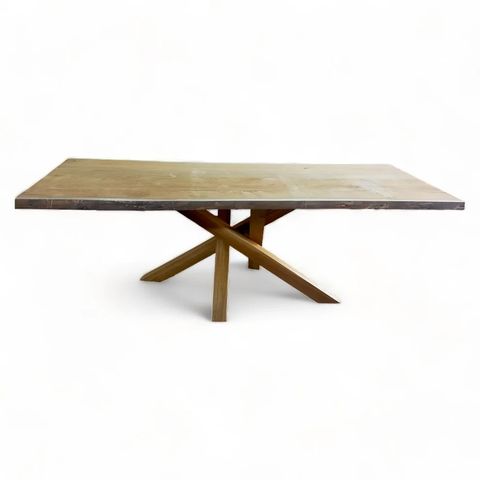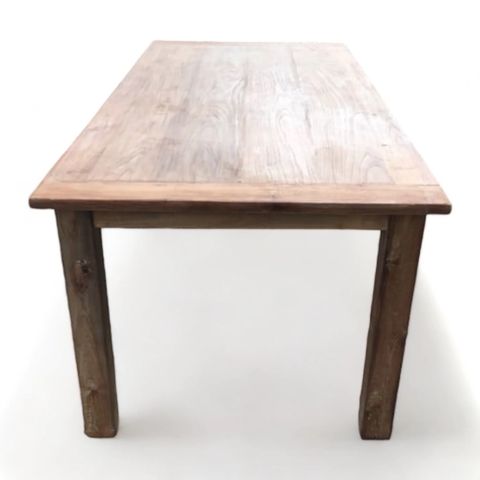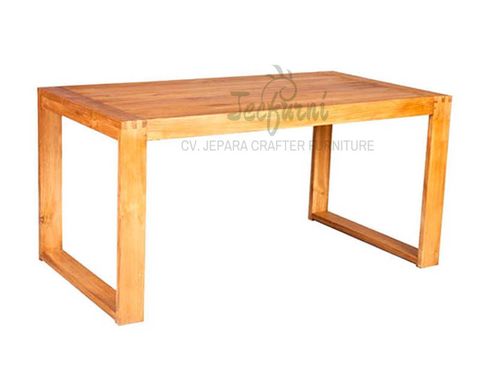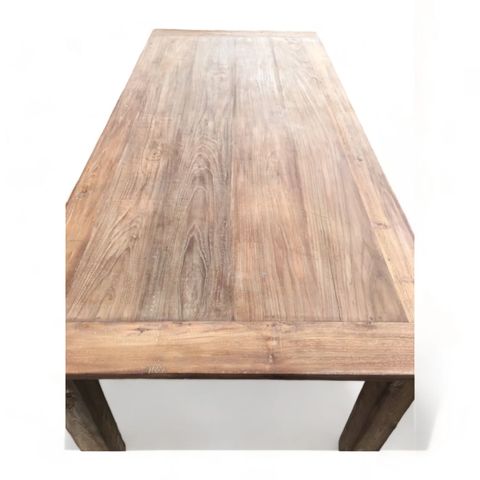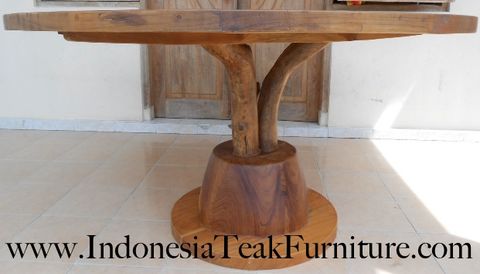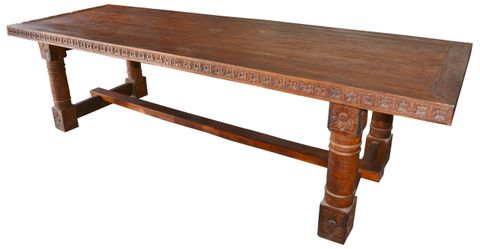Every Indonesian teak wood dining table tells a story. Not just of the timber itself, but of generations of skilled craftsmen who’ve perfected their craft over centuries. These aren’t merely furniture pieces – they’re heirlooms that carry the soul of Indonesia’s woodworking traditions.
When you sit down to dinner around a beautiful Indonesian teak wood dining table, you’re not just enjoying a meal. You’re participating in a tradition that spans hundreds of years. The process of creating these magnificent pieces involves careful selection of timber, precise craftsmanship, and deep respect for both materials and the cultural heritage they represent. What makes these tables so special isn’t just their durability or beauty, but the stories they hold within their grain lines and the hands that shaped them.
The Sacred Properties of Indonesian Teak
Indonesian teak wood, scientifically known as Tectona grandis, holds a special place in the hearts of artisans and homeowners alike. This remarkable timber comes from the tropical regions of Southeast Asia, particularly Indonesia, where it grows in the dense forests of Java, Sumatra, and Kalimantan. The wood’s natural oils and silica content make it incredibly resistant to insects, decay, and weathering. These properties have made it highly sought after for construction, shipbuilding, and furniture making throughout history.
The distinctive golden-brown color that develops over time adds to its appeal. When first harvested, the wood appears pale yellow, but exposure to air and light gradually transforms it into a rich amber hue. This natural aging process is one of the most prized characteristics of teak, as each table develops its own unique patina with use.
Traditional Indonesian craftsmen have long recognized these qualities. They understand that teak wood isn’t just a material to work with – it’s a partner in their craft. The wood’s straight grain patterns and tight texture provide ideal conditions for detailed carving and intricate joinery work. Many tables feature elaborate designs that highlight the wood’s natural beauty while showcasing the artisan’s skill.
Historical Roots and Cultural Significance
The tradition of teak wood table making in Indonesia goes back centuries, with evidence suggesting that skilled craftspeople were creating beautiful furniture as early as the 16th century. During the colonial period, Indonesian artisans adapted European design influences while maintaining their distinctive local techniques. This fusion created a unique style that blended functionality with aesthetic appeal.
In traditional Indonesian society, dining tables served as more than practical furniture. They represented family unity, social status, and cultural identity. Large family gatherings, religious ceremonies, and important community meetings often centered around these wooden tables. The size, design, and craftsmanship of a table could indicate the wealth and social standing of the household.
Many families passed down their table-making skills through generations, with master craftsmen teaching apprentices the secrets of their trade. These knowledge systems included not just technical skills but also cultural understanding of how to properly care for and maintain teak furniture. The wisdom accumulated over centuries continues to influence modern practices today.
Today, Indonesian teak dining tables are found in homes across the archipelago and beyond. They serve as symbols of Indonesian heritage, connecting modern families to their ancestors through shared meals and traditions. The tables often become family heirlooms, passed down through generations, carrying with them stories, memories, and cultural values.
The Selection Process and Material Preparation
Creating a quality Indonesian teak wood dining table begins with selecting the right timber. Skilled craftsmen look for logs that show good grain patterns, minimal knots, and consistent coloration. The wood must be properly seasoned before use, which can take anywhere from several months to several years. Proper seasoning allows moisture to escape naturally, preventing warping and cracking during the final construction process.
The cutting process requires precision and experience. Artisans carefully plan how to cut the log to maximize usable material while preserving the wood’s natural beauty. They consider grain direction, potential defects, and the intended final shape of the table.
After cutting, the wood undergoes additional preparation including sanding, smoothing, and sometimes applying natural treatments to enhance its appearance and protect it from environmental factors. Many traditional makers prefer to use only natural oils and waxes rather than chemical finishes, allowing the wood to breathe and age gracefully.
Quality control is ongoing throughout the process. Each piece is carefully inspected for flaws or inconsistencies. The attention to detail at this stage ensures that the final product will be both beautiful and durable. Some craftsmen even test the wood’s stability by placing weights on different sections to verify structural integrity before beginning the actual construction.
Traditional Construction Techniques
The construction of Indonesian teak wood dining tables involves several traditional methods that have been refined over generations. One of the most important aspects is the joining technique used to connect different parts of the table. Traditional craftsmen often employ mortise and tenon joints, which create strong connections that can last for decades. These joints require precise measurements and careful fitting to ensure they hold securely without the use of nails or screws.
Another crucial element is the method of shaping and carving. Many Indonesian tables feature carved elements such as legs, corner details, or decorative panels. These carvings are typically done using hand tools rather than power equipment, allowing for greater control and artistic expression. The process can take days or weeks to complete, depending on the complexity of the design.
The table top itself is usually crafted with special attention to flatness and stability. Artisans may use multiple pieces of wood joined together, ensuring that the grain patterns complement each other visually. The surface is carefully planed and sanded to achieve a smooth finish that feels pleasant to the touch.
Some traditional techniques involve the use of natural adhesives made from plant-based materials. These alternatives to modern glues are often preferred because they’re less likely to cause damage to the wood over time and are more environmentally friendly. The entire construction process emphasizes patience and craftsmanship over speed and mass production.
Design Elements and Regional Variations
While Indonesian teak dining tables share common characteristics, regional variations showcase the diversity of local traditions and influences. In Java, for example, tables often feature elegant curves and detailed carving work that reflects Islamic and Javanese design elements. The famous ‘Keraton’ style incorporates royal motifs and formal proportions that speak to the region’s historical connection to royal courts.
Sumatran tables might emphasize simpler, more functional designs with clean lines and minimal ornamentation. The cooler climate of northern Indonesia influenced these styles toward more robust construction and practical features.
Bali’s approach to teak table making often includes vibrant colors and nature-inspired patterns, reflecting the island’s tropical culture and spiritual beliefs. Some tables feature carved motifs of flowers, birds, or mythical creatures that tell stories or convey messages about prosperity and harmony.
Modern Indonesian artisans continue to draw inspiration from these regional traditions while adapting to contemporary tastes and needs. They might combine classical elements with minimalist design principles, or blend traditional joinery techniques with modern finishing methods. The result is a wide variety of styles that appeal to different preferences and lifestyles.
Each design choice reflects not just aesthetic considerations but also cultural values and practical requirements. Whether you prefer ornate carvings or simple elegance, there’s likely a regional tradition that matches your taste.
Care and Maintenance for Longevity
Proper care is essential to preserve the beauty and longevity of Indonesian teak wood dining tables. While teak is naturally resistant to many elements, regular maintenance helps maintain its appearance and structural integrity.
Regular cleaning with a soft cloth and mild soap solution removes dirt and debris that can accumulate in the wood grain. It’s important to avoid harsh chemicals or abrasive cleaners that could damage the surface. After cleaning, always dry the table thoroughly to prevent water spots.
Periodic application of natural oils like teak oil or linseed oil helps maintain the wood’s luster and protects it from moisture. These treatments should be applied every six months to a year, depending on usage frequency and environmental conditions.
Protecting the table from extreme temperature changes and direct sunlight helps prevent cracking or fading. While teak handles weather well, prolonged exposure to intense heat or cold can affect its stability.
For serious scratches or damage, it’s best to consult a professional craftsman who understands the proper repair techniques. Attempting to fix major issues yourself could compromise the table’s structure or appearance.
Many owners find that their teak tables develop a lovely patina over time, which is actually a sign of proper aging rather than deterioration. This natural change in color and texture adds character and uniqueness to each piece, making every table truly one-of-a-kind.
The art of Indonesian teak wood dining table making represents far more than simple furniture craftsmanship. It embodies centuries of cultural knowledge, artistic expression, and practical wisdom. Every table tells a story of tradition, skill, and dedication to quality that spans generations. When you choose an Indonesian teak dining table, you’re not just acquiring furniture – you’re investing in a piece of living history that will continue to tell stories for years to come.
These tables remind us that true craftsmanship isn’t about speed or mass production, but about patience, respect for materials, and a deep understanding of how things should be made. In our fast-paced world, they offer a moment of connection to something lasting and meaningful. Whether you’re drawn to their natural beauty, their durability, or their cultural significance, Indonesian teak dining tables represent the very best of traditional woodworking artistry. The investment in one of these pieces pays dividends not just in daily use, but in the satisfaction of knowing you possess a genuine work of art that honors both past and future generations.

